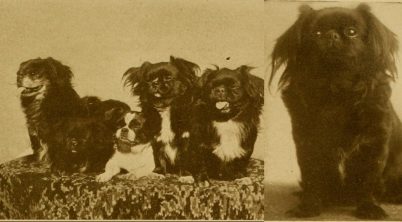Pet Pekingese Dog Eye Infection: Common Types and Effective Treatments
Pekingese dogs, known for their distinctive appearance and affectionate nature, are prone to experiencing eye problems due to their physical characteristics. Eye infections, in particular, are a common issue for these pets. Understanding the causes and symptoms of eye infections in Pekingese dogs can help owners spot issues early and seek appropriate treatment for their beloved companions.
Eye problems in Pekingese dogs can be caused by various factors, including allergies, fleas, and infection. Common symptoms of eye infections in these dogs include redness, discharge, and dry eye. It’s essential for pet owners to monitor their Pekingese for any signs of eye issues and consult a veterinarian for a proper diagnosis and treatment plan when needed.
Some of the potential treatments for eye infections in Pekingese dogs include antibiotics, eye drops, and in some cases, surgery. The course of treatment will depend on the underlying cause of the infection and the severity of the symptoms. By staying informed about the risks and symptoms of eye infections, Pekingese owners can ensure their pets remain healthy and comfortable.
Pekingese Dog Eye Structure
Unique Features
The Pekingese dog breed has a distinctive eye structure characterized by large, protruding eyes and a flattened facial appearance. Their eyes are round and are set far apart, giving them a unique appearance. The breed’s brachycephalic facial structure can also contribute to eye-related issues, as it reduces the protective features typically found in breeds with longer snouts.
Vulnerability to Infections
Due to their unique eye structure and facial conformation, Pekingese dogs can be more susceptible to eye infections and other ocular problems. Some common Pekingese eye issues include dry eye, red eyes, and eye discharge, which could be caused by factors such as allergies, fleas, and infections. The breed’s brachycephalic airway syndrome might also influence their lower-respiratory and gastrointestinal diseases, further affecting eye health.
Treatments for Pekingese eye infections can range from antibiotics for bacterial infections, eye drops to soothe irritation, to surgeries in cases of blocked tear ducts or eyelid abnormalities. Regular veterinary checkups are essential to monitor and maintain the eye health of Pekingese dogs.
To help prevent eye infections and issues, it is crucial to keep their eyes clean by gently wiping them with a clean, damp cloth daily. Also, it’s essential to address any underlying causes, such as allergies or fleas, to reduce the chances of eye problems arising.
Common Eye Infections
Conjunctivitis
Conjunctivitis, also known as pink eye, is a common eye infection in dogs, including Pekingese. It occurs when the mucous membrane, called the conjunctiva, becomes inflamed. This condition can be caused by various factors, such as allergies, viruses, bacteria, or irritants like smoke and dust.
Some symptoms of conjunctivitis in Pekingese dogs include redness, swelling, and discharge from the eye. If you notice your Pekingese exhibiting these signs, it is essential to consult with a veterinarian for proper diagnosis and treatment. Early intervention can help prevent complications and ensure your pet’s eye health.
Keratitis
Keratitis refers to the inflammation of the cornea, which may result from infections, injury, or exposure to irritants. Pekingese dogs are particularly susceptible to this condition due to their prominent eyes and shallow eye sockets. Symptoms of keratitis include redness, pain, excessive tearing, and sensitivity to light.
Proper treatment for keratitis in Pekingese dogs depends on the underlying cause. In some cases, antibiotic or antiviral medications may be prescribed, while in others, lubricating eye drops or ointments may be necessary. A veterinarian will determine the best course of action based on the specific needs of your pet.
Dry Eye
Dry eye, also known as keratoconjunctivitis sicca, is a condition that affects the tear production in a dog’s eyes. It can lead to discomfort, irritation, and potential vision issues if left untreated. Pekingese dogs are prone to suffering from dry eye due to factors such as their breed, age, and certain medications.
Common signs of dry eye in Pekingese dogs include a thick, yellowish discharge, redness, and persistent squinting or blinking. Treatment options for this condition may involve artificial tear supplements, medicated eye drops, or in some cases, surgery. For the best care and management of dry eye, consult with your veterinarian to determine the most appropriate intervention for your Pekingese dog.
Signs and Symptoms
Pekingese dogs are prone to eye infections due to their prominent eyes and shallow eye sockets. Identifying the signs and symptoms of an eye infection early can help ensure proper treatment and care for your furry friend.
Common signs and symptoms of an eye infection in a Pekingese dog include:
- Redness in and around the eye
- Swelling or inflammation
- Clear, cloudy or yellowish discharge
- Squinting, blinking, or keeping the eye closed
- Light sensitivity
- Pawing at the eye or rubbing their face
Eye infections in Pekingese dogs can be caused by various factors such as bacteria, viruses, allergies, or debris getting lodged in the eye. It is important to monitor your pet for any changes in their eye appearance or behavior to catch a potential infection early on.
If you suspect your Pekingese has an eye infection, consult with a veterinarian for proper diagnosis and treatment. A professional assessment is necessary to determine the root cause and prescribe the appropriate treatment course for your dog’s specific condition.
Causes of Eye Infections
Pekingese dogs are prone to certain eye problems, and it’s important to understand the causes so owners can help prevent infections and maintain the health of their pet’s eyes. This section explores the factors that contribute to eye infections in Pekingese dogs, including environmental factors, genetics, and underlying health issues.
Environmental Factors
Various environmental factors can lead to eye infections in Pekingese dogs. Allergens, such as pollen or dust, can irritate the eyes and cause infections. Additionally, harmful bacteria or viruses, like distemper or canine herpes, can be present in the dog’s environment and potentially cause eye infections. Fleas can also contribute to eye irritation and infection in Pekingese. To help reduce the risk of eye infections, owners should keep their dog’s living environment clean and free of allergens and pests.
Genetics
Some Pekingese dogs may have a genetic predisposition for eye infections. Pekingese are more susceptible to eye infections due to the hair around the folds of skin near the eyes acting as an irritant. For preventing infections caused by irritation, regular grooming and hair maintenance is crucial.
Underlying Health Issues
Underlying health issues or conditions can contribute to eye infections in Pekingese dogs. Blocked tear ducts, poor eye health, and tumults are some examples of health problems that can lead to eye infections. It is essential to monitor the overall health of a Pekingese dog and seek veterinary care if any issues arise, in order to address any infections or other eye concerns that could develop as a result of these health problems.
Diagnosis and Testing
To diagnose an eye infection in a Pekingese dog, a veterinarian will perform a thorough examination of the dog’s general health and its eyes. They will check for signs of respiratory infection and examine the size of its lymph nodes for indications of overall health.
Upon examining the dog’s eyes, the veterinarian will look for common symptoms such as redness, discharge, swelling, and changes in the eye’s appearance. The vet may also conduct several tests to diagnose the infection more accurately, such as:
- Schirmer Tear Test: This test measures the eye’s tear production and is performed when redness or discharge is present.
- Visual Examination: The veterinarian will compare one eye with the other to identify any abnormalities or differences in appearance.
These tests help determine the underlying cause of the eye infection and the best course of treatment for your Pekingese dog. It is essential to address any eye issues in your Pekingese promptly to prevent further complications and ensure your pet’s overall health and well-being.
Treatment Options
Medication
For a pekingese dog eye infection, medication might be required depending on the underlying cause. Common medication options include topical and oral antibiotics, as well as anti-inflammatory drugs to treat bacterial infections. These medications can help to alleviate symptoms, eliminate the infection, and prevent further complications.
Surgery
In more severe cases, surgery might be necessary to address the issue causing the eye infection. It is essential to consult with a veterinarian to discuss whether surgery is the most suitable treatment option for your pekingese dog’s specific situation.
Home Remedies
While medication and surgery can be effective treatment options, there are also some home remedies that can provide supportive care and promote comfort for your pekingese dog.
- Saline rinses: Non-medicated sterile saline rinses can be used to flush the eye and temporarily alleviate irritation caused by the infection. This can be done three to four times a day using an eyedropper.
- Gentle cleaning: Use a soft cloth to gently clean the dog’s eye area, removing any debris or discharge. This can help prevent further irritation and promote healing.
- Soothing eyewash: A warm water solution with a few drops of gentle eyewash can be applied to the affected eye to provide soothing relief.
- Cold compress: Apply a cold compress to the dog’s eye for 20 minutes to reduce inflammation and discomfort.
Remember to consult with a veterinarian before attempting any home remedies, as they may have specific recommendations tailored to your pet’s individual needs and the severity of their eye infection.
Preventive Measures
One of the key aspects of maintaining your Pekingese’s eye health is keeping the fur around their eyes clean and trimmed. Regular grooming helps prevent irritants and debris from entering the eye, which can lead to infections. For best results, gently clean the area around their eyes with a damp cloth or cotton ball to remove any debris and dried tear stains.
Aside from grooming, there are a few more steps you can take to protect your Pekingese’s eyes from infection. These include:
- Using flea and tick preventatives to control the risk of parasites, which can cause eye irritation and infections. Follow your veterinarian’s advice on the best products for your dog.
- Keeping hazardous substances, like cleaning products and chemicals, out of your dog’s reach to avoid accidental contact with their eyes.
- Avoiding exposing your Pekingese to excessive dust, pollen, and other allergens that could cause eye irritation.
- Monitoring your dog’s eyes for signs of discomfort or inflammation and seeking prompt veterinary care if you notice any issues.
In addition to these tips, regular veterinary check-ups can help detect and prevent the development of eye infections in your Pekingese dog. Your veterinarian may also recommend an appropriate eye wash or rinse to use regularly to keep their eyes clean and free from irritants.
Furthermore, it is important to educate yourself on specific eye-related conditions in Pekingese dogs, such as entropion or cherry eye, as mentioned by the American Kennel Club. Being informed about these conditions can help you identify the symptoms early, making it easier to seek veterinary care and prevent further complications.
When to Consult a Veterinarian
Evaluating your Pekingese dog’s eye health is crucial in detecting infections and other issues early. It’s important to observe your pet for signs of discomfort or changes in their eyes that may require veterinary attention. A few indicators that it’s time to consult a veterinarian include:
- Discharge: Thick white or yellow eye discharge may indicate a serious eye infection that needs professional attention. This is especially concerning if it is accompanied by a pus-like discharge
- Redness & Swelling: If you notice persistent redness, swelling, or irritation around your dog’s eyes even after rinsing or cleaning the area, it may be a sign of a more severe issue requiring a vet visit
- Cloudy or Discolored Eyeballs: Changes in the clarity or color of your dog’s eyes may indicate an infection or other eye problem that needs to be diagnosed and treated by a professional
- Excessive tearing and squinting: If your Pekingese dog shows signs of excessive tearing or squinting, especially if it’s accompanied by other symptoms like redness and discharge, seek veterinary guidance
- Pawing at the eyes: Pawing at the eyes is a common sign of discomfort, irritation or itchiness that could be caused by an eye infection or another issue. If your Pekingese is repeatedly pawing at his or her eyes, it’s time to consult a veterinarian for a proper check-up and diagnosis
In summary, it’s vital to monitor your Pekingese dog’s eye health regularly, and if you observe any symptoms or changes that cause you concern, do not hesitate to consult a veterinarian. Early diagnosis and treatment of eye infections can help prevent complications or further health issues and ensure your beloved pet remains healthy and comfortable.








